Postal Service to End At-Door Delivery
The US Postal Service is struggling to make delivery more efficient.
Struggling with an antiquated business model, the US Postal Service is looking to make delivery more efficient.
CNN Money (“Postal Service looks to end at-your-door mail“):
If you’re moving to a newly built house, say goodbye to mail delivery at your door.
And if some House Republicans get their way, all door-to-door mail delivery will go away.
The U.S. Postal Service is marching towards a more “centralized delivery,” where residents pick up their own mail from clusters of mail boxes located in their neighborhood. Local postmasters are sending hundreds of letters to fast-growing communities, warning that cluster boxes will be the way mail will be delivered to new developments.
In the past year, the cash-strapped Postal Service has been asking companies in industrial parks and shopping malls to also adopt this form of mail delivery.
But Rep. Darrell Issa, the California Republican leading the House effort to save the postal service, wants more. He has made doing away with doorstep delivery a key part of his bill, which would require everyone to get mail at a curbside box or from a cluster box.
“A balanced approach to saving the Postal Service means allowing USPS to adapt to America’s changing use of mail,” said Issa, who is chairman of the House Oversight and Government Reform Committee.
Moving away from door-to-door delivery saves a lot of money. Right now, 35 million residences and businesses get mail delivered to their doorstep.
It costs $353 per stop for a delivery in most American cities, taking into account such things as salaries and cost of transport. By contrast, curbside mail box delivery costs $224, while cluster boxes cost $160, according to a report from the Postal Service’s Office of Inspector General.
Delivering mail is the agency’s largest fixed cost — $30 billion. Ending such door deliveries would save $4.5 billion a year. That’s more than the $3 billion it would have saved from ending Saturday mail service, according to government reports.
This makes good, practical sense. As I’ve noted many times, it’s silly to treat mail delivery as a for-profit business. It’s part of a nation’s infrastructure and should be treated as such. But that doesn’t mean we have to be stupid about it, either. Current delivery patterns have little rhyme or reason; they’re vestiges of a different time.
Most people who live in apartments and other high-rise arrangements tend to have clustered delivery, regardless of how nice they are. I doubt Donald Trump gets his mail delivered directly to his door, at least by the Postal Service.
In most houses I’ve lived, we had to walk down to the street to get our mail where it was delivered by someone riding in a truck and who dismounted only if they needed to bring a package to the door. At my parents’ current house in Alabama, where we moved 33 years ago, we had to pick up mail across a high-traffic road because it had once been part of the old Rural Route system. Eventually, they deigned to pick it up on the residential road itself–but all the boxes had to the on one side of the road, such that the driver could just go around the loop one time.
But, when I lived in a newly built townhouse complex in Ashburn, Virginia a decade ago, the mailboxes were all clustered at central locations. At the other end of the spectrum, my mother-in-law’s house down the road still has a postman delivering mail on foot to a little box mounted on the door; so did the house my late wife and I lived in when we first got married. Why? Well, because that’s how they delivered mail when those houses were built.
My current neighborhood has variation. There are three parallel cul-de-sacs connected by a perpendicular road. Then there’s another, smaller, cul-de-sac off that road in the other direction. Finally, there’s an even more private cul-de-sac-like enclave nestled in behind the three cul-de sacs. Most of us get our mail delivered to a box at the bottom of our driveways but the people in the cul-de-sac-like enclave and the smaller cul-de-sac off the connecting road have clustered boxes. Frankly, given how much of a time suck driving down cul-de-sacs is, we should all be picking our mail up from a box on the connecting road.
Shifting to clustered delivery where it’s reasonable and taking away the odd perk of door-to-door delivery would save billions of dollars with minimal inconvenience to customers.
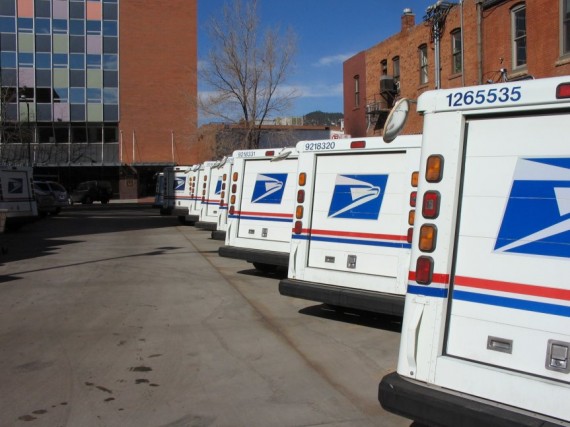

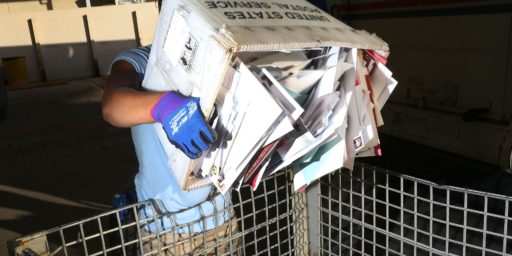
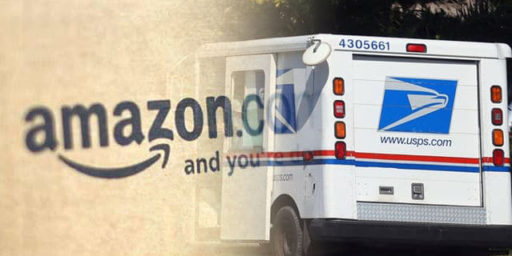

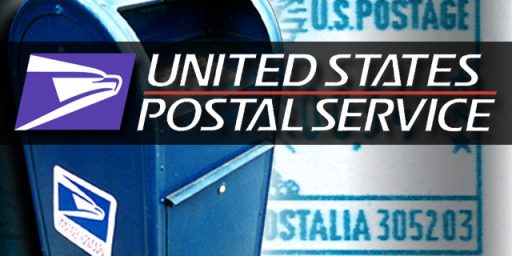
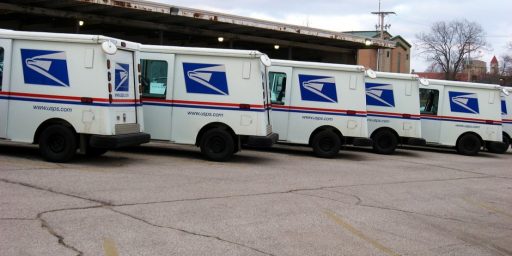
This will come as sad news to many of our four footed friends of the canine population.
Our mail carriers in our town walk a lot of the routes.
However I see nothing all that awful about a cluster style system. My sister lived in a neighborhood with cluster mailboxes. It wasn’t a big deal-on most days she or her husband drive by their mailbox cluster multiple times so stopping to get the mail want that big a deal.
There’s another advantage to a system of clusterbox delivery. As it’s done now every day, Monday through Saturday, rain or shine, our mail is dropped on our doorstep by a mail carrier. Now, if it’s dry that’s fine. However, if it’s raining, we end up with soaked mail.
I also suspect that clusterbox delivery would hasten the move to all-electronic for tax refunds, etc. for security reasons if nothing else.
I wonder how row houses will be handled? In older cities like DC or Philadelphia, there’s no place for cluster boxes, nor for roadside boxes. I suppose door-to-door might continue as the only real alternative would be to have everyone go to the Post Office to collect their mail.
I was under the impression that the Post Office wasn’t requiring or asking existing neighborhoods to move to cluster boxes but only new neighborhoods use the method.
That said there are some neighborhoods where cluster boxes aren’t going to work, but just about anywhere in a suburban neighborhood they would. Not sure that they would work well in extremely rural places either (houses too far apart for cluster boxes).
We have a cluster box in our 30 year old neighborhood. The boxes are locked, so they are safer, Plus there are larger boxes for packages, The key is left in your mailbox. Much more secure than UPS which just dumps your packages on the front stoop.
If they went to 3 days a week delivery, it would be just fine with me.
Scott is right, 3 days a week is what they should go to. 1/2 the people get mail MWF, the other half TRS. It would cut the number of mail carriers in half and it would not effect service very much at all. I can wait a day to get bills and junk mail.
The other advantage of the clustered boxes is that they’re have locks, which individual mailboxes rarely do, which cuts down concerns about either incoming or outgoing mail being stolen.
@Just Me:
Truthfully, there are very few if any places they won’t work. I have lived in many inner city neighborhoods and any of them could accommodate cluster boxes. It is possible there are city environments where they would not work but not in my limited experience (St Louis and environs). As to rural communities there is absolutely no reason they would not work there. Everybody already has a car and they go to work everyday already.
Myself, I have a PO Box and pick up my mail once a week. Been doing this for 20 years during which time I have lived in the city, suburbs, small towns, and now the deep woods. It is simple, easy, and secure.
@Dave Schuler:
No it won’t, Dave. A lot of the working poor don’t have bank accounts.
Next step: no door to door delivery in rural areas. Can’t wait to see the rural states explode into action insisting how USPS home delivery is an “essential government service.”
Maybe I’m missing something here, but doesn’t this require the Post Office to buy, possibly through the use of some hereto unknown eminent domain power, pieces of property every few blocks across the country? I think there is a reason they are targeting and warning “new developments” because the post office can coerce the developers to arrange for clusterbox locations under threat that the post office will not otherwise deliver.
It might be easy in urban settings where the city owns most of the property fronting houses and the post office can make arrangements with the city. But in a lot of suburban settings, the city may be have nothing more than rights to access underground lines.
@Just Me: a lot of rural places already have general delivery, where you get your mail at the post office.
Issa needs to stick to his fake scandals and leave operational matters of governmental departments to those who actually have experience in how to run them. This is what happens when doofuses like Issa get re-elected several times, they receive positions of power which they have no business acquiring. He’s out of his depth and needs to move back to the shallow end of the pool where he can splash around with the other kiddies who need lots of media attention.
@Scott: Question: who owns and maintains the boxes? Who manages the keys such as issuing and collecting? Does the post office do this? Where would the land for that come from?
@Tyrell:
The land would probably be part of an easement. They wouldn’t have to pay for it.
@OzarkHillbilly:
I’m aware of that. I don’t think the two are mutually exclusive. So, for example, the modern SNAP program works more like a debit card system except without the bank.
BTW, whereabouts are you from? I grew up in St. Louis, my mom was born in St. Joe, and I have family in Gasconade.
it cant work everywhere…most of the houses out here are 2000 feet apart…
Clustering works fine as far as it goes, but if you add No Saturday delivery AND raise the cost to junk mailers then you’d have something.
Gosh, if it wasn’t delivered to right next to my door, I might never remember to go get that junk. I’d rather keep my door delivery and get it 3 days a week either MWF or Tue-Thur-Sat.
@Robert Prather: Easements are property rights that have to be purchased.
Apparently the Post Office does have eminent domain power, its just that it doesn’t ever remember having used it.
@rjs: “it cant work everywhere…most of the houses out here are 2000 feet apart…”
Well, maybe some of them good ol’ boys should have considered that before voting in morons who believe the only duty of the government is to shovel money at billionaires.
You don’t like they way they’re screwing you over? Hey, stop voting for Republicans.
@john425: “Clustering works fine as far as it goes, but if you add No Saturday delivery AND raise the cost to junk mailers then you’d have something. ”
Yes, we could finally finally finally afford another tax cut for billionaires.
@PD Shaw: so the city pays for the land to put sidewalks in front of your house? I’m not saying you’re wrong, but I’m curious.
@Rob Prather:
An easement is a non-possessory interest in land that gives the holder the right to do what the easement document describes. It might be to install and maintain a sidewalk, or install and access utility lines. All easements are potentially different and usually are.
An easement also restrains the owner of the property from doing anything that would interfere with the described purpose of the easement. My city aggressively brings lawsuits against property owners that put anything on the described easement that it deems would make it more difficult to access the utility lines. They passed an ordinance which describes those things that are permitted.
So a property owner may not agree that the city’s easement allows a third-party to do something not described on the written easement. The city might not want a structure on its easement that interferes with its prerogatives (which may go beyond the easement itself, but to issues of blocking sight lines, traffic, liability and maintenance). This seems like a lot of potential work to me for something that might be obsolete in twenty years.
@wr: What streamlining the USPS and putting it on a sound basis has to do with tax breaks for billionaires is beyond me.
The PO is an anachronism and yet I too, will mourn it’s passing somewhat. FedEx, UPS, e-mail, Twitter and other, just emerging technologies will hasten it’s demise. It’s all about delivering content and you just have to see the newspaper and book industries to see the future of the USPS.
I don’t recall the last time I paid for a newspaper as I can read all I want online. My Seattle paper has a base of “free” articles before they block me and want a digital subscription but I have registered with several such digital newspapers and can get all the news I want. Bye, bye, newspapers. Can the Post Office be far behind?
I know the neighborhood association in my historic community would pitch a fit before they’d allow cluster mailboxes to be installed on the corners. These folks are very well connected politically, and would drag out the process for years.
I applaud the USPS for trying to save money, but I’m with the 3-days-per-week crowd as the best way to do so.
@OzarkHillbilly:
Ozark,
I don’t know about you but depending on how “rural” your area is, the number of square miles that all have to use the same cluster box out in the country could be quite a lot. I’m betting most people who live out in the country don’t want to drive 5-10 miles in a direction they don’t normally drive just to pick up their mail from a cluster box. It’s only convenient to “already be in your car” if you pass by the box. And there would have to be parking also, it’s not as if you could just have an easement & have people walk up to it (like where there are sidewalks) when they had to drive to get there.
And if you receive a package that is too large for the “package box” you have to make time to go to the Post Office when it’s open to pick up the package. And usually there’s a time limit on how long the post office will hold those packages before returning to sender. Take into account the number of post offices in rural areas that are switching their hours to only be open on certain days or for only a few hours a day & I see a lot of people in rural communities being upset by the postal service. Sending of letters may be down because of email & the internet but sending of packages has gone up, especially with UPS & FedEx doing handoffs to the Post Office for final delivery.
Most post offices in rural areas that are still open everyday to the public would have to switch to being open late at least one evening a week so people can pick up packages. Honestly I don’t know why they don’t do this already, most government offices (think the DMV, etc), and community offices like the library or the local city/township office already have one day a week they are open later for those who need to come in but have to work during the day.